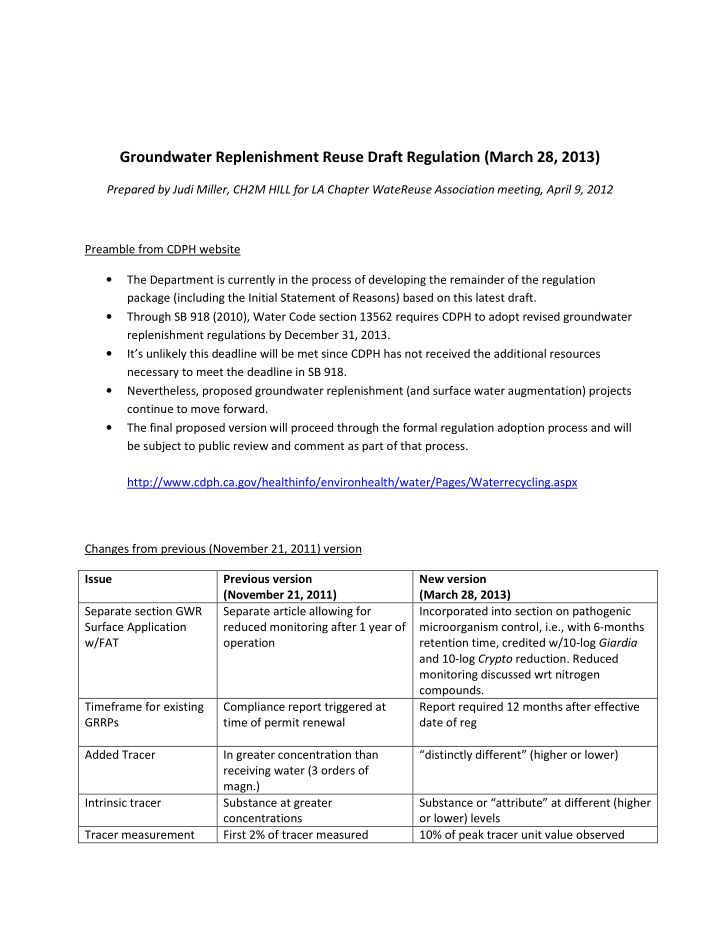



Groundwater Replenishment Reuse Draft Regulation (March 28, 2013) Prepared by Judi Miller, CH2M HILL for LA Chapter WateReuse Association meeting, April 9, 2012 Preamble from CDPH website The Department is currently in the process of developing the remainder of the regulation • package (including the Initial Statement of Reasons) based on this latest draft. Through SB 918 (2010), Water Code section 13562 requires CDPH to adopt revised groundwater • replenishment regulations by December 31, 2013. It’s unlikely this deadline will be met since CDPH has not received the additional resources • necessary to meet the deadline in SB 918. Nevertheless, proposed groundwater replenishment (and surface water augmentation) projects • continue to move forward. The final proposed version will proceed through the formal regulation adoption process and will • be subject to public review and comment as part of that process. http://www.cdph.ca.gov/healthinfo/environhealth/water/Pages/Waterrecycling.aspx Changes from previous (November 21, 2011) version Issue Previous version New version (November 21, 2011) (March 28, 2013) Separate section GWR Separate article allowing for Incorporated into section on pathogenic Surface Application reduced monitoring after 1 year of microorganism control, i.e., with 6-months w/FAT operation retention time, credited w/10-log Giardia and 10-log Crypto reduction. Reduced monitoring discussed wrt nitrogen compounds. Timeframe for existing Compliance report triggered at Report required 12 months after effective GRRPs time of permit renewal date of reg Added Tracer In greater concentration than “distinctly different” (higher or lower) receiving water (3 orders of magn.) Intrinsic tracer Substance at greater Substance or “attribute” at different (higher concentrations or lower) levels Tracer measurement First 2% of tracer measured 10% of peak tracer unit value observed
Issue Previous version New version (November 21, 2011) (March 28, 2013) downgradient downgradient Zone of restricted well Added secondary boundary of zone of development potential restricted well development in which well siting triggers further study. Map revised when conditions change Compliance monitoring RWQCB can use available data to determine compliance if project sponsor fails to complete required monitoring Wastewater source RWQCB can also (in addition to CDPH) control specify chemical and contaminant source investigations required Pathogenic Treatment processes required to At least 3 treatment processes required to microorganism log be credited with ≥1-log be credited with ≥1-log reduction credit Nitrogen compounds Reduced monitoring based on Reduced monitoring based on only Total-N Total-N, NO3, NO2 & NO3+NO2 Sampling grab Grab or composite, except for diluents water; TOC have to demonstrate or if RO- treated Diluent Water Reqs. Secondary MCL If approved by the Department, recharge water may be monitored in lieu of a diluent water source if the diluent water source cannot be monitored directly in a manner that provides samples representative of the diluent water being applied. RWC Initial max. RWC ≤0.20 Initial max. RWC ≤0.20 unless an alternative initial RWC is approved by the Department …and the project sponsor demonstrates that the treatment processes preceding the soil-aquifer treatment process will reliably meet the TOC criterion: (≤0.5 mg/L/proposed RWCmax.) for 20-week running average for 52 wks) Notification after exceedance of Notification after “knowledge of” criteria exceedance of criteria Assessing SAT Monitor TOC Monitor TOC, indicator compounds, and performance surrogate parameters Prior to a new GRRP beginning initial operation and at five-year intervals thereafter, the project sponsor shall conduct a study to determine the occurrence of indicator compounds in the recycled municipal wastewater to be applied at the GRRP. Following completion
Issue Previous version New version (November 21, 2011) (March 28, 2013) of the study, the project sponsor shall propose at least three indicator compounds for use in meeting subsection (g) re: quarterly monitoring of these compounds. Notification Levels Single exceedance triggers Single exceedance triggers additional notification of CDPH and RWQCB monitoring. 4-week avg. exceedance and possibly local well water triggers notification of CDPH and RWQCB; agencies 16-week consec. Exceedance may trigger suspension. Operations Plan Submit to CDPH Submit to CDPH and RWQCB Reporting Annually No later than 6 months after the end of each calendar year Increases in RWC during the previous calendar year and RWC increases anticipated for the current calendar year. GWR Subsurface Baseline well 2 samples 4 quarterly samples monitoring Membranes 99.5% NaCl rejection Min. 99% NaCl rejection; avg. ≥99.2% NaCl rejection; modified test conditions Occurrence study “pilot” testing Not restricted to pilot-scale testing Monthly sampling FAT effluent < MCL or NL FAT effluent < MCL (only)
Recommend
More recommend